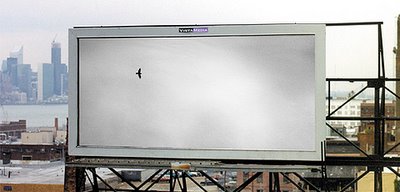 Felix Gonzalez-Torres, Untitled, 1995
Felix Gonzalez-Torres, Untitled, 1995Looking over my notes for Adbusters' art issue (#61), for which I was guest art editor, I came upon an interview with Robert Storr that didn't make the cut. A curator, critic, and artist, Storr is also Rosalie Solow Professor of Modern Art at NYU and one of the more interesting critics writing on contemporary art today. While our discussion was brief, it was dense and wide-ranging. In belated thanks for him taking the time, I offer a few excerpts.
On art's social function:
What art does is it open people's minds... In some cases, it opens them up directly to certain social public issues, in some cases merely the fact of reminding people... that their imaginations can in fact stretch to encompass ideas that probably were alien, and that itself is a social thing. The social function of art in a culture where things are very restricted, where horizons are deliberately kept low, can be in the declarative sense quite small, and have profound ramifications because it helps people to dream, it helps them to imagine realities that they're told are a waste of their time. In other cases you may have a social crisis coming to a head and artists articulate more clearly and more engagingly than others.On Felix Gonzalez-Torres (1957-1996) as an example of socially engaged art:
Everything under the sun he used to get content into places where people weren't expecting it. He also understood that the best way to get at people who were not necessarily part of the community of opinion… is to bring it in on some level where they can get intrigued, seduced, delighted by something and then discover that there's a tough part also. Much socially engaged art begins by being declarative and making people aware that they're now on notice that they're going to get something they're going to have to respond to that has something demanding or challenging in it.[Read Storr's 1995 interview with Gonzalez-Torres here.]
On art and social change:
I don't think art can change the world. There are moments in history—in the 1930s and the 1920s and since—where very direct address of general social problems by artists has had something of an effect. It's hard to say what it was or how to quantify it, but it's undeniable they spoke for the times and people knew it. There are other times when merely the presence of a voice of dissent or a kind of questioning in public for which art is also a vehicle can do a lot.For interview excerpts with curators, artists, and professors, including Jennifer Gonzalez, Hou Hanru, Rirkrit Tiravanija, and others, see "Can art change the world?"
I'm also of the view that sometimes people who should be socially active take refuge in art and make art as an alternative to being involved in the sort of nuts and bolts and oftentimes boring business of organizing and voting and demonstrating and doing all that. I think we've been through a period where a lot of people have very sophisticated political ideas based on a whole series of postmodern thinkers but actually they do almost nothing, and they have avoided the full implications of having a political understanding of the world by having such a good rap. I don't know how many students I've spoken to, taught, and dealt with who can tell you all about the crisis of late capitalism but in fact have never done anything political in their lives, or very little, and who can tell you all about what's wrong with other people's political practice but haven't made any mistakes yet… There's a dimension in which a lot of political postmodernism is a kind of shadowboxing, and I think that that is something really to be questioned.
1 comment:
Form/Space Atelier Program For April 2008
Show Title: An Exhibit Of Robert Storr's Autograph And Other Work
Show Duration: April 11-May 4
Opening Reception Friday, April 11, 6PM
An Exhibit Of Robert Storr's Autograph And Other Work is the century mark in terms of the number of exhibits of fine art that have been curated by Paul Pauper. This exhibit pays homage to the legacy Paul Pauper established with regard to assembling massive group shows during the early part of his curatorial career. An Exhibit Of Robert Storr's Autograph And Other Work features sculpture by John Hawkley, photographs by Dan Hawkins, paintings by Stacey Chapelle and the rare and precious autograph of Robert Storr, the Dean of the Yale School of Art, critic, painter and one of the most influential people in the history of art. Bread and wine will be served at this reception, placed site-specifically on a twenty-foot-long table, covered with a solemn black cloth, intentionally representing a sacred feast. Non-alcoholic beverages, Bibi Cafe, will also be served for those unable to take the sacramental offering. Conversely, cheerful balloons will be attached to the Form/Space Atelier A-Board, site-specifically representing the profusion of balloons attached to local-area condominium sales office A-Boards. Visitors to the exhibit are encouraged to "speculate" on the meaning of both the sacramental installation and the balloon installation.
Post a Comment